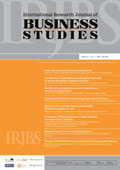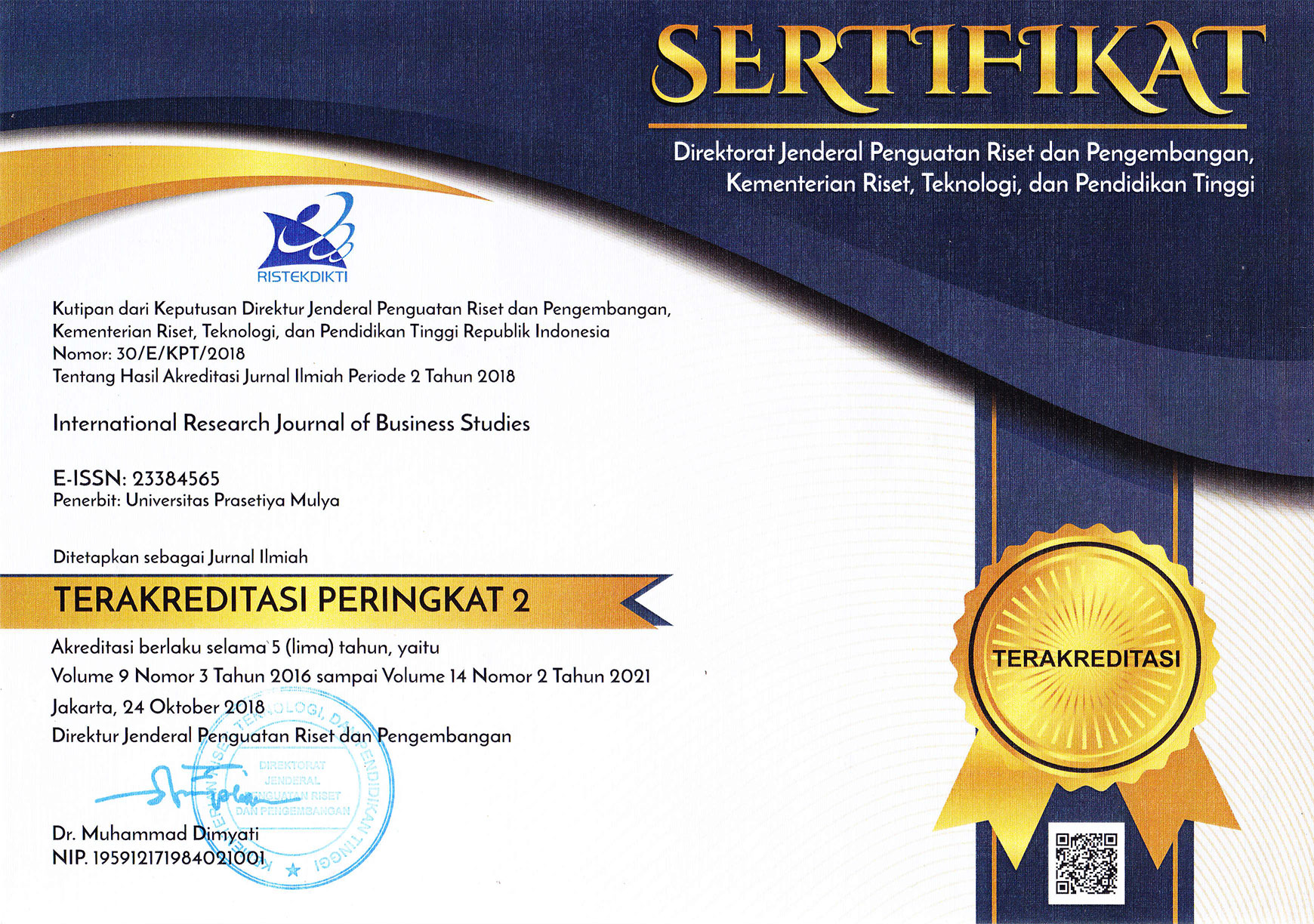Article Metrics |
|
|
E-commerce Platform Performance, Digital Marketing and Supply Chain Capabilities
Abstract
By using Indonesian case studies, this research plan to fill the research gap (conceptual, methods and contexts) in the theories of transaction cost economics, multi-attribute utility theory, agency theory and information-processing theory, through variable based modeling. For business and industry stakeholder point of view, this research is expected to be useful for Indonesian e-commerce platform ecosystem stakeholders especially regulators, to give insights towards dynamics within e-commerce platform ecosystem. This paper originality lies on proposing e-commerce conceptual model by using multidisciplinary approach through combining four main constructs, which consists of relative e-commerce platform performance, digital promotion capability, customer experience review rating and supply chain capabilities. The model also accommodates seasonal pricing and logistic outsourcing as intervening variables to examine model sensitivity. With sample size of 1288 people who have purchased items in at least two e-commerce platform, collected data is processed using Structural Equation Modeling (SEM) method by LISREL software.
Keywords:
E-commerce; Digital Marketing, Supply Chain Capability, E-commerce Performance, Customer Review Rating
* School of Business and Management, Bandung Institute of Technology, Bandung, Indonesia
** Faculty of Economics and Business, Universitas Indonesia, Depok, Indonesia
Full Text:
References
L. Hsiao and Y. J. Chen (2013). The perils of selling online: Manufacturer competition, channel conflict, and consumer preferences, Marketing Letters, 24(3), 277–292, https://doi.org/10.1007/s11002-012-9216-z
A. Hortaçsu and C. Syverson (2015). The Ongoing Evolution of US Retail: A Format Tug-of-War. Journal of Economics Perspective, 29(4), 89–112, https://doi.org/10.3386/w21464
K. Picot-Coupey, E. Huré, and L. Piveteau (2016). Channel design to enrich customers’ shopping experiences: Synchronizing clicks with bricks in an omni-channel perspective – the Direct Optic case. International Journal of Retail and Distribution Management, 44(3), 336–368, https://doi.org/10.1108/IJRDM-04-2015-0056
M. Hänninen, A. Smedlund, and L. Mitronen (2018). Digitalization in retailing: multi-sided platforms as drivers of industry transformation. Balti. J. Management, 13(2), 152–168, https://doi.org/10.1108/BJM-04-2017-0109
R. Boateng, R. Hinson, R. Heeks, and A. Molla (2008). E-commerce in least developing countries: Summary evidence and implications. Journal of African Business, 9(2), 257–285, https://doi.org/10.1080/15228910802479919
H. R. Greve and S. Y. Song (2017). Amazon warrior: How a platform can restructure industry power and ecology. Advances in Strategic Management, 37, 299–335, https://doi.org/10.1108/S0742-332220170000037010
A. Molla and R. Heeks (2007). Exploring e-commerce benefits for businesses in a developing country. The Information Society, 23(2), 95–108, https://doi.org/10.1080/01972240701224028
J. Joong-Kun Cho, J. Ozment, and H. Sink (2008), Logistics capability, logistics outsourcing and firm performance in an e-commerce market. International Journal of Physical Distribution & Logistics Management, 38(5), 336–359, https://doi.org/10.1108/09600030810882825
Y. H. Hsiao, M. C. Chen, and W. C. Liao (2017). Logistics service design for cross-border E-commerce using Kansei engineering with text-mining-based online content analysis. Telematics and Informatics, 34(4), 284–302, https://doi.org/10.1016/j.tele.2016.08.002
C. G. Cegielski, L. Allison Jones-Farmer, Y. Wu, and B. T. Hazen (2012). Adoption of cloud computing technologies in supply chains: An organizational information processing theory approach. International Journal of Logistics Management, 23(2), 184–211, https://doi.org/10.1108/09574091211265350
J. Luo, S. Ba, and H. Zhang (2012). The effectiveness of online shopping characteristics and well-designed websites on satisfaction. MIS Quarterly, 36(4), 1131-1144, https://doi.org/10.2307/41703501
C. H. Wong, G. W. H. Tan, B. I. Tan, and K. B. Ooi (2015). Mobile advertising: The changing landscape of the advertising industry. Telematics and Informatics, 32(4), 720–734, https://doi.org/10.1016/j.tele.2015.03.003
O. E. Williamson (2009). Pragmatic methodology: A sketch, with applications to transaction cost economics. Journal of Economic Methodology, 16(2), 145–157, https://doi.org/10.1080/13501780902940729
S. Fayezi, A. O’Loughlin, and A. Zutshi (2012). Agency theory and supply chain management: A structured literature review. Supply Chain Management, 17(5), 556–570, https://doi.org/10.1108/13598541211258618
I. Sirkeci and L. B. Magnúsdóttir (2011). Understanding illegal music downloading in the UK: A multi-attribute model. Journal of Research in Interactive Marketing, 5(1), 90–110, https://doi.org/10.1108/17505931111121543
M. Bonera (2011). The propensity of e-commerce usage: The influencing variables. Management Research Review, 34(7), 821–837, https://doi.org/10.1108/01409171111146706
W. Gong (2009). National culture and global diffusion of business-to-consumer e-commerce. Cross Cultural Management: An International Journal, 16(1), 83–101, https://doi.org/10.1108/13527600910930059
C. C. Defee and B. S. Fugate (2010). Changing perspective of capabilities in the dynamic supply chain era. International Journal of Logistics Management, 21(2), 180–206, DOI:10.1108/09574091011071915
Y. Yu, X. Wang, R. Y. Zhong, and G. Q. Huang (2017). E-commerce logistics in supply chain management Implementations and future perspective in furniture industry. Industrial Management and Data Systems, 117(10), 2263–2286, https://doi.org/10.1108/IMDS-09-2016-0398
Y. S. Yen (2010). Can perceived risks affect the relationship of switching costs and customer loyalty in e-commerce?. Internet Research, 20(2), 210–224, https://doi.org/10.1108/10662241011032254
E. Bakker, J. Zheng, L. Knight, and C. Harland (2008). Putting e-commerce adoption in a supply chain context. International Journal of Operations and Production Management, 28(4), 313–330, https://doi.org/10.1108/01443570810861543
H. Karjaluoto, N. Mustonen, and P. Ulkuniemi (2015). The role of digital channels in industrial marketing communications. Journal of Business & Industrial Marketing,, 30(6), 703–710, https://doi.org/10.1108/JBIM-04-2013-0092
S. Zhou, B. Sun, W. Ma, and X. Chen (2018). The pricing strategy for Fuji apple in Shaanxi of Chain under the e-commerce environment. Kybernetes, 47(1), 208–221, https://doi.org/10.1108/K-06-2017-0230
I. Pentina and R. W. Hasty (2009). Effects of multichannel coordination and e-commerce outsourcing on online retail performance. Journal of Marketing Channels, 16(4), 359–374, https://doi.org/10.1080/10466690903188021
N. Gudigantala, P. Bicen, and M. (Tae in) Eom (2016). An examination of antecedents of conversion rates of e-commerce retailers. Management Research Review, 39(1), 82–114, https://doi.org/10.1108/MRR-05-2014-0112
E. Hartmann and S. Herb (2014). Opportunism risk in service triads - a social capital perspective. International Journal of Physical Distribution & Logistics Management, 44(3), 242–256, https://doi.org/10.1108/IJPDLM-08-2012-0249
S. Sahney, K. Ghosh, and A. Shrivastava (2013). Buyer’s motivation’ for online buying: An empirical case of railway e-ticketing in Indian context. Journal of Asia Business Studies, 8(1), 43–64, https://doi.org/10.1108/JABS-07-2011-0036
Wijanto (2008). Structural Equation Modelling dengan LISREL 8.8: Konsep dan Tutorial. Graha Ilmu, PA: Yogyakarta.
M. Kim, J. Kim, J. Choi, and M. Trivedi (2017). Mobile Shopping Through Applications: Understanding Application Possession and Mobile Purchase. Journal of Interactive Marketing, 39, 55–68, https://doi.org/10.1016/j.intmar.2017.02.001
B. Aslam and H. Karjaluoto (2017). Digital advertising around paid spaces, E-advertising industry’s revenue engine: A review and research agenda. Telematics and Informatics, 34(8), 1650-1662, https://doi.org/10.1016/j.tele.2017.07.011
Y. J. Kim and J. Han (2014). Why smartphone advertising attracts customers: A model of Web advertising, flow, and personalization. Computers in Human Behavior, 33, 256–269, https://doi.org/10.1016/j.chb.2014.01.015
A. B. Bower and J. G. Maxham (2012). Return shipping policies of online retailers: Normative assumptions and the long-term consequences of fee and free returns. Journal of Marketing, 76(5), 110–124, https://doi.org/10.1509%2Fjm.10.0419
Sharma, S. (1996). Applied Multivariate Techniques. John Wiley and Sons Inc., PA: New York
R. Ramanathan, U. Ramanathan, and H. L. Hsiao (2012). The impact of e-commerce on Taiwanese SMEs: Marketing and operations effects. International Journal of Production Economics, 140(2), 934–943, https://doi.org/10.1016/j.ijpe.2012.07.017
Tikno (2017). Measuring performance of facebook advertising based on media used: A case study on online shops in Indonesia. Procedia Computer Science, 111, 105–112, https://doi.org/10.1016/j.procs.2017.06.016
Copyright (c) 2020 INTERNATIONAL RESEARCH JOURNAL OF BUSINESS STUDIES
International Research Journal of Business Studies has been covered by the following services: | ||||||||||||||||||||||||
|




















